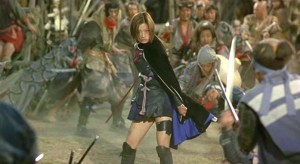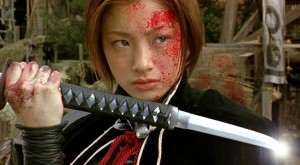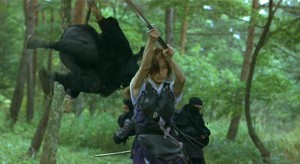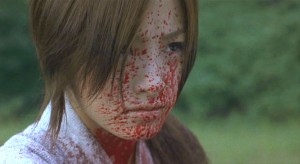Azumi

Ryuhei Kitamura’s Versus was a huge cult hit that secured him a following all over the world. It was a down and dirty zombie-fu movie that mixed Evil Dead II with John Woo and Takashi Miike, and while it had much to amuse and entertain it suffered from the same problems that plague Kitamura’s Azumi. Versus would have been a nearly perfect piece of trash at 84 minutes. Unfortunately it was 119, and made the enormous mistake of taking its bogus mythology seriously, eventually wearing out its welcome. Azumi appears to want to rise above trash, but Kitamura is limited by his abilities, and his attempts to escalate the flimsy material are admirable but fruitless.
Versus was in no way original, but it had oodles of energy, the camera constantly on the move, and a willingness to be utterly lowbrow and over the top in its violence with savage beheadings, body severs, and removal of limbs. Azumi is made with the same lack of creativity (hey look, a shot through a newly created hole in the hand, never seen that before), but done in a completely serious fashion, and with no advantage of having excessively humorous gore. Sure, there are sword slashings and endless blood sprays, but all of it done in exactly the same way, hundreds, and I do mean hundreds, of times.
Azumi opens with some ambitious but awful CGI of some crows and it is indicative of the rest of the film, which attempts to be an epic with an enormous scope, but seems to define that as an overlong and ill-defined and dreamy movie which repeats itself every 20 minutes or so. If a plot twist occurs (and I use that term loosely), characters feel the need to explain the same piece of information to each new person who didn’t know it before.
 The plot of Azumi is underdeveloped and slapped together. We begin with ten enthusiastic warriors all training to be assassins under their master. Azumi, the one female of the group, is said to be the strongest of all of them and as they are assigned a mission by their master, to go after a list of three warlords which would supposedly stop future warfare (although he doesn’t tell them the reason why they do anything). This covers the first twenty minutes, and from then on there is a fight every ten minutes or so, and we learn nothing further about any of the characters, who dwindle in numbers with no impact on the audience. So if we can’t take it seriously as an epic, perhaps as no-brainer action movie? Kitamura never commits to either type of film.
The plot of Azumi is underdeveloped and slapped together. We begin with ten enthusiastic warriors all training to be assassins under their master. Azumi, the one female of the group, is said to be the strongest of all of them and as they are assigned a mission by their master, to go after a list of three warlords which would supposedly stop future warfare (although he doesn’t tell them the reason why they do anything). This covers the first twenty minutes, and from then on there is a fight every ten minutes or so, and we learn nothing further about any of the characters, who dwindle in numbers with no impact on the audience. So if we can’t take it seriously as an epic, perhaps as no-brainer action movie? Kitamura never commits to either type of film.
There is much that is frustrating about the movie, considering the potential here. It seems to want to be both balletic and gory but holds back on both accounts. There is some wire fu, but it is rather unenthusiastic and limited. The gore is sporadic and not graphic. The fights are extremely long and numerous, but unlike Hero, they are without grace or skill, and seem rather unorganized and rushed. The camera never seems to be anywhere for a particular reason, it is always arbitrarily placed, and composition is indifferent.
I think what Kitamura wanted to do was make an updated version of Duel to the Death in his own style, but doesn’t realize what worked in that film. First, the ninjas that appear in Duel to the Death make glorious and extravagant entrances, often making shocking appearances at the corner of the frame. The ninjas in Azumi are always telegraphed, and then there is a whooshing noise on the soundtrack to signify that they have either just left, or are moving. That’s not to say that there aren’t plenty of entrances in Azumi, some characters have three or four within the same fight scene. But that plays up to one of the larger problems with the film. Duel to the Death is 86 minutes, Azumi is 143.
 The editing is another point of frustration, as Kitamura frequently cuts away just as the slashings are about to occur, and the one on one battles are overly protracted (except in a particularly well handled case that takes place in an open field), and the large scale ones are excessively long and repetitive. Another quibble, despite the enormous number of enemies in the film, many from different backgrounds and groups, they all follow standard kung fu behavior, that is, attack the heroes only one at a time.
The editing is another point of frustration, as Kitamura frequently cuts away just as the slashings are about to occur, and the one on one battles are overly protracted (except in a particularly well handled case that takes place in an open field), and the large scale ones are excessively long and repetitive. Another quibble, despite the enormous number of enemies in the film, many from different backgrounds and groups, they all follow standard kung fu behavior, that is, attack the heroes only one at a time.
The Gladiator-cam, the verite, you-are-there shaky camerawork, is employed far too often, and as usual, entirely ineffectively. The score is a mix of pseudo-Enya and cheesy late 80’s rock, which is completely out of place.
The dialogue is repetitive and silly, the gee-whiz type that even George Lucas might find embarrassing. The characters are purposefully naïve, but most of the time their goals are never established, we never know why exactly they want to be assassins, nor what particularly is gained by their mission. Early on, we see a flashback involving the Master agreeing that all warlords who intend to continue in an endless war should be exterminated. Fine, but how does it help that in this movie, hundreds of people are killed, and sides which were not even fighting before, have joined the battle, causing more and more strife? Won’t the result of that be even more reason to fight than had gone in before?

Since the movie is named for Azumi, you would think that she would have some sort of interesting characteristic, perhaps a flashier fighting style, something unique. Alas, the only thing distinctive about her is the fact that she is female, and cute, which is noted by each new foe. The only interesting characters are two of the villains, one who dresses completely in white, is quite effeminate, and refuses to defend himself as he dismisses and taunts his opponents, and another who has the characteristics of a dog; ears, smell, etc. Whenever these two are not on screen, especially in the second half of the film, the movie is flat and dull.
And worse, there is a desperate attempt to set up a sequel in the final section, which is odd, because the movie forgets its story in the last half hour of the film, and becomes one long fight scene. Kitamura may believe that the ending leaves it open for future material, but really, this story is incomplete because he didn’t bother to finish it.



